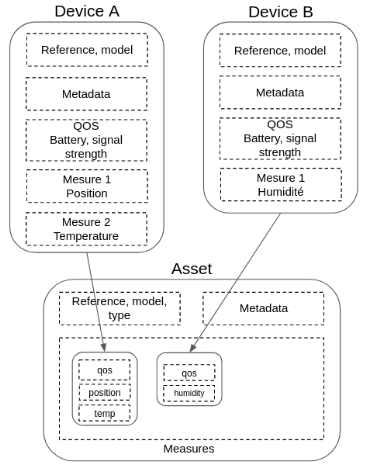Assets #
An asset document represents the physical asset to which one or more devices can be linked.
The document contains asset identification information, the latest measurements received by the associated devices and their metadata.
An asset is uniquely identified by the type + model + reference triplet.
Example: Asset document with a GPS measure
{
"type": "<asset type>",
"model": "<asset model designation>",
"reference": "<asset model unique identifier>",
"measures": {
"position": {
"id": "<associated device unique identifier>",
"model": "<associated device model>",
"reference": "<associated device reference>",
"qos": {
"battery": 2.3
},
"latitude": 41.074688,
"longitude": 28.9800192,
"accuracy": 42,
"altitude": 12,
"updatedAt": "<timestamp of the measure>",
"payloadUuid": "<identifier of the received payload>",
}
},
"metadata": {
"owner": "Ayse"
},
}Copy measures from devices #
When a device is linked to an asset, it will automatically propagate the new measurements it receives into the asset's measures property.
By default, for each measurement type the following information are copied in addition of the measure content:
id: device document unique identifiermodel: device modelreference: device referenceqos: device qos info

Example: Content of asset document linked to a device with a temperature measure
{
"reference": "XYZ-42-AZE",
"model": "PERFO-GTX1",
"metadata": {},
"measures": {
"temperature": {
"id": "IneoGTO42-98765poiuyt",
"model": "IneoGTO42",
"reference": "98765poiuyt",
"qos": {
"battery": 2.3
},
// Measure content
"updatedAt": 1610561030361,
"payloadUuid": "...",
"degree": 23.3,
}
},
}It is possible to override the Decoder.copyToAsset method to choose what to copy into the asset.
Historization #
Assets are historized in the asset-history collection when a new measure is received.
Before historization, the engine:<engine-index>:asset:measure:new event is emitted.
The payload contain the asset updated content and the types of the new added measures.
At the end of the processing, the asset will be updated and historized with the content of the request.result.asset._source.
app.pipe.register(`engine:<engine-index>:asset:measures:new`, async (request: KuzzleRequest) => {
const asset = request.result.asset;
const measureTypes = request.result.measureTypes;
if (measureTypes.includes('position')) {
request.result.asset._source.metadata = {
city: 'Adrasan',
};
}
return request;
});